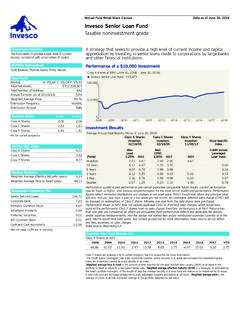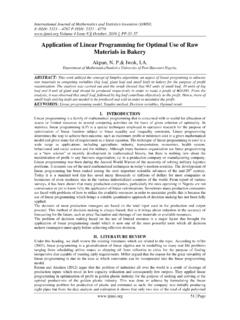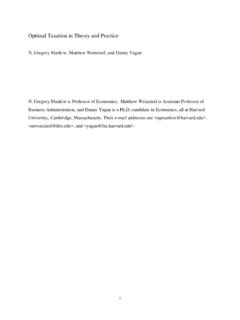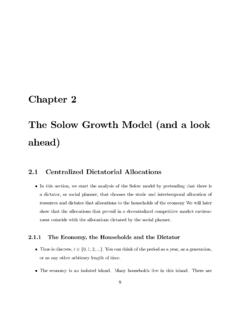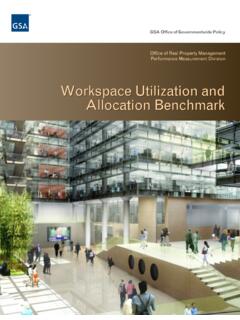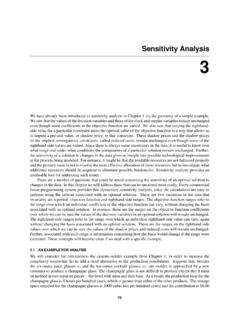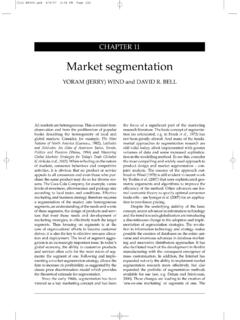Transcription of The Big Picture Global Asset Allocation 2022 Outlook
1 The Big Picture Global Asset Allocation 2022 OutlookQuarterly update From Invesco s Global Market Strategy Office21 November 2021 Data as of of 29 October 2021 unless stated otherwiseNovember 2021 1 The Big Picture Global Asset Allocation : 2022 Outlook Given our view that 2022 will be a year of transition and that Asset class returns will converge, we adopt a more balanced approach within our Model Asset Allocation , though still maintain a preference for cyclical assets. We reduce the equity Allocation to Neutral and increase the Allocation to bonds, by raising high-yield credit (to Maximum) and investment-grade credit (to just below Neutral), though we reduce government bonds to the Minimum allowed. From a regional perspective we have added to emerging market (EM) and Eurozone allocations, while reducing exposure to the US and Japan.
2 We also consider alternative scenarios. Model Asset Allocation In our view: Equities offer limited potential as the Global economy slows. We reduce to Neutral. Real estate (REITS) has the potential to produce the best returns. We stay at Maximum. Corporate high-yield (HY) is now more attractive (relative to equities). We increase to Maximum. Corporate investment-grade (IG) yields have increased. We increase to Neutral. Government debt Outlook is poor. We reduce to Minimum. Cash returns are low but stable and de-correlated (it is our diversifier of choice). We stay at Maximum. Commodities are supported by the cycle but some are expensive. We reduce to Zero. Gold is threatened by rising yields and a stronger USD. We remain at zero.
3 Regionally, we favour the UK and EM (and are Underweight US assets)Our best-in-class assets (based on 12m projected returns) UK equities EM real estate EM IG USD cashFigure 1 Projected 1-year returns for Global assets and neutral portfolio Based on annualised local currency returns. Returns are projected but standard deviation of returns is based on 5-year historical data. Size of bubbles is in proportion to average pairwise correlation with other assets. Cash is an equally weighted mix of USD, EUR, GBP and JPY. Neutral portfolio weights shown in Figure 3. As of 29 October 2021. There is no guarantee that these views will come to pass. See Appendices for definitions, methodology and disclaimers. Source: BAML, MSCI, GSCI, FTSE, Refinitiv Datastream and Invesco Global Market Strategy Office The Big Picture November 2021 2 Table of contents Summary and conclusions: 2022 - a year of transition.
4 3 Model Asset Allocation * .. 5 A glance in the rear-view mirror .. 6 Taking a step back: focusing on the next decade using Invesco s CMAs .. 7 Politics in 2022: US politics back to centre stage .. 8 The Global economic cycle: deceleration and inflation .. 9 From economic to market cycles .. 11 Projections for 2022 .. 14 Model Asset Allocation : towards more 17 Equity factors and sectors .. 18 What could go wrong? Five scenarios for 2022 .. 19 Appendices .. 21 Appendix 1: Global valuations vs history .. 21 Appendix 2: Asset class total returns .. 22 Appendix 3: Invesco 10-year Capital Market Assumptions (USD version) .. 23 Appendix 4: Key assumptions .. 24 Appendix 5: Methodology for Asset Allocation , expected returns and optimal portfolios.
5 25 Appendix 6: Definitions of data and benchmarks .. 26 Appendix 7: IIS Capital Market Assumptions methodology (Figure 5 & Appendix 3).. 28 Important information .. 29 Global Market Strategy Office The Big Picture November 2021 3We still prefer cyclical assets but are now less aggressive Slowdowns often produce convergence of returns Underlying assumptions 10-year treasury yield torise to process favours real estate, HY and cash Equities reduced and credit boosted Real estate still our favourite cyclical Asset We prefer cash to gold as a diversifier Summary and conclusions: 2022 - a year of transition Given our view that 2022 will be a year of transition and that Asset class returns will converge, we adopt a more balanced approach within our Model Asset Allocation , though still maintain a preference for cyclical assets.
6 We reduce the equity Allocation to Neutral and increase the Allocation to bonds, by raising high-yield credit (to Maximum) and investment-grade credit (to just below Neutral), though we reduce government bonds to the Minimum allowed. From a regional perspective we have added to emerging market (EM) and Eurozone allocations, while reducing exposure to the US and Japan. After deep recession and a strong rebound, we suspect the Global economy is now decelerating towards a more normal rate of growth (perhaps 4% GDP growth in 2022). At the same time inflation has reached levels not seen for some time, though we expect it to peak in mid-2022 and to ease thereafter. Though we believe the current upswing will last for a number of years, we note that this slowdown phase of the economic cycle is often accompanied by a convergence of Asset class returns.
7 Coming after a period of strong outperformance by cyclical assets, we think it is now time to adopt a more balanced approach within our Model Asset Allocation (see Figure 3 for the details). Underpinning our Asset projections for 2022 are the following assumptions: Central bank tapering starts and Asset purchases cease in many countries Central banks start the process of normalising (increasing) their policy rates (weassume two rate hikes from the Fed and even more from the BOE) Government bond yields rise across the maturity spectrum but yield curves start toflatten towards the end of the forecast horizon (bear flattening) IG and HY spreads narrow slightly and default rates decline USD strengthens marginally as bond yield spreads move in its favour Equity dividend growth slows.
8 Yields remain stable (except for a slight rise in the US) Real estate (REIT) dividends rebound, pushing yields higher Commodities consolidate recent gains (and gold falls due to rising yields/dollar)The full set of assumptions is shown in Appendix 4, while the resultant market targets are shown in Figure 20 and projected returns for Global assets are shown in Figures 1 and 22. Perhaps the most important forecast is that the 10-year US treasury yield will rise to and that consequently the US dollar will strengthen slightly. This suggests to us a re-emergence of some earlier trends (outperformance of value versus growth, weakness of gold and defensive fixed income assets). However, it also suggests that commodity prices may find it harder to advance from here (especially given that many of them are now expensive, in our view).
9 Not surprisingly, given the information in Figure 1, our optimisation process favours cash and real estate and accords minimum allocations to government bonds, gold and commodities (see Figure 21). Interestingly, high-yield credit (HY) is also favoured, while the results vary for equities and investment-grade credit (IG). Hence, within our Model Asset Allocation , we have chosen to reduce the equity Allocation to a Neutral 45%, versus the previous Overweight 54% and have now reduced commodities to zero (see Figure 3). Though we boost the overall Allocation to fixed income categories (yields are higher), we reduce the government bond Allocation to the Minimum 10% (from 19%). These reductions allow us to boost the Allocation to credit, with high-yield (HY) going to the Maximum 10% (from 2%) and investment-grade (IG) rising to 9% (versus the previous zero and just below the Neutral Allocation of 10%).
10 Real estate remains our favourite cyclical Asset . It may suffer a loss of demand for office and retail space as a result of Covid-19 but we find the yields to be attractive and expect growth to resume as economies recover. We remain at the Maximum 16% Allocation but have reduced the US and Japan while boosting EM and the Eurozone. Cash remains our defensive Asset of choice (low returns, low volatility and low correlation place it on the efficient frontier). Notwithstanding the rise in inflation, we think gold will struggle if treasury yields and the dollar rise, so we maintain a zero Allocation . Global Market Strategy Office The Big Picture November 2021 4EM is our favoured region We prefer the basic resources sector to commodities What if we are wrong?

